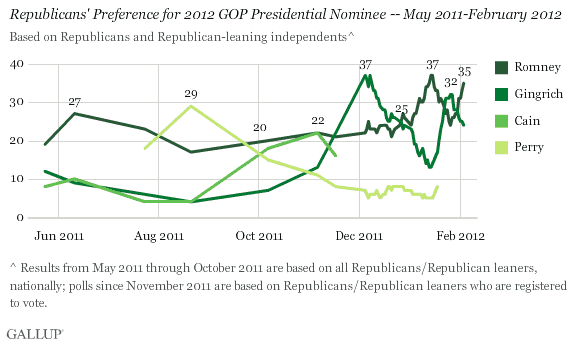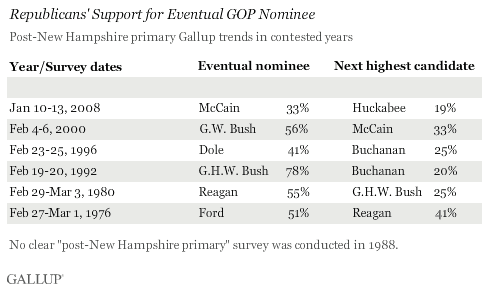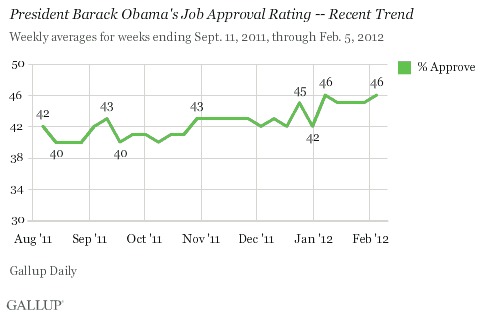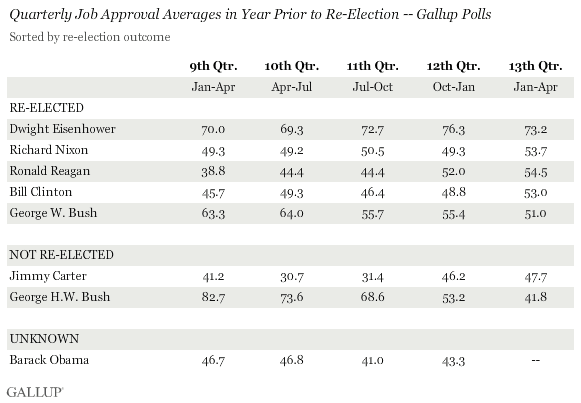PRINCETON, NJ -- U.S. President Barack Obama beats several of his possible Republican opponents in recent Gallup general election trial heats, but he is tied with GOP front-runner Mitt Romney, suggesting he could be facing a competitive race this fall. Aside from the degree of difficulty presented by his ultimate opponent, the president may face more challenging odds if a number of other key indicators do not improve over the next several months. These include his job approval rating, Americans' satisfaction with the way things are going in the country, the public's assessment of the economy, and the continuing dominance of the economy when Americans are asked to name the nation's most important problem.
The following summarizes what we know at this point about each factor that ultimately will help determine the outcome of the U.S. presidential election.
1. The Republican Nominee
Romney is supported by 35% of Republicans nationally in Gallup latest update, based on interviews conducted Jan. 30-Feb. 3, with Newt Gingrich favored by 24%, Rick Santorum by 16%, and Ron Paul by 12%.
Romney's 50% to 21% win over Gingrich in Saturday's Nevada GOP caucuses may increase Romney's national lead further. Romney's ultimate ability to capture his party's nomination, however, is currently far from certain. Romney has led the GOP field at more points over the past year than any other candidate, but his share of the vote has never exceeded 37% in what has proved to be a historically volatile race. The lead switched seven times in Gallup's 2011 polling, and since January has switched twice more, first with Gingrich pulling ahead of Romney in mid-January and then Romney recapturing the lead in the past week.

The proportional structure of the Republican nomination process this year is such that no Republican candidate can mathematically amass a winning percentage of GOP delegates for several months. This drawn-out process makes it harder for Romney to cement his status as front-runner or inevitable nominee, and gives Gingrich, Santorum, and Paul hope as they continue to campaign.
Since 1976, the first competitive GOP contest after the McGovern-Fraser commission reforms, the Republican candidate who was in the lead in Gallup's first polling in February has always gone on to win the GOP nomination. If 2012 follows that historical pattern, Romney will eventually be the Republican nominee. But such historical "rules" have already been broken this year. Gallup typically found a dominant GOP front-runner in the year prior to the nomination campaign, and that front-runner went on to win the nomination in all contests except 2008. Last year, the GOP had no clear front-runner. Also, from 1976 to 2008, the national GOP leader after New Hampshire in Gallup's polling always maintained the lead through the end of the campaign and won the nomination. This year was different, as Romney was the national leader after New Hampshire but fell behind Gingrich after the South Carolina primary.

Although Romney's current 35% of national Republican support is significantly below the majority threshold, this is not an unusual position for the eventual GOP nominee at this point in the campaign. Bob Dole had 41% support in early February 1996, and Reagan 34% in February 1980.
2. The Public's View of the Incumbent President's Performance
Obama's job approval rating in Gallup Daily tracking is at 46% for the week ending Feb. 5. His weekly approval ratings have remained at the 45% to 46% level each week so far this year. Obama's current job approval rating in Gallup's tracking is below the historical threshold of winning incumbents, although it has shown marked improvement in recent months, after matching his term-low 40% weekly average in October. Obama's three-day job approval rating reached 47% in Gallup tracking at one point in January. Additionally, although Gallup did not conduct Daily tracking interviews Feb. 3-4, a separate Gallup poll conducted Feb. 2-5 found 50% of Americans approving of Obama, suggesting the president may have received an approval bounce after Friday's jobs report. These results indicate that Obama is generally not far from reaching a job approval situation more conducive to his re-election.

The three presidents since World War II who were not re-elected -- Gerald Ford, Jimmy Carter, and George H.W. Bush -- all had job approval ratings below 50% in the last Gallup measure before the election took place. Five presidents who won re-election -- Dwight Eisenhower, Lyndon Johnson, Richard Nixon, Ronald Reagan, and Bill Clinton -- all had job approval ratings above 50% in the last Gallup poll before the election. Two presidents were re-elected with sub-50% approval ratings. George W. Bush had 48% approval in October 2004 among national adults. Harry Truman's final Gallup job approval rating in 1948 was 40%, but that was from a poll conducted nearly five months before Election Day, making it unclear precisely what Truman's level of support was at the time of the election.
This historical pattern suggests that Obama would need to see his job approval rating climb to 50% to be in a comfortable position for re-election. History shows that by March of the election year, all winning presidents in the modern era, including George W. Bush, had job approval ratings above 50%, and all losing presidents had job approval ratings below 50%. This suggests that where Obama stands by next month may be an important indicator of his ultimate re-election chances.

3. Satisfaction With the Way Things Are Going in the U.S.
Americans' broader views of how things are going in the country are also related to incumbent presidents' success in winning a second term.
In Gallup's Feb. 2-5 update, 22% of Americans say they are satisfied with the way things are going in the U.S. today. This is up from 18% in January, although still below the 26% recorded last May. Satisfaction reached its all-time low of 7% in October 2008.
Satisfaction was 40% or higher at roughly this juncture in the re-election years for the three most recent winning presidents. It was 45% in February 2004 when George W. Bush sought re-election, 41% in early March 1996 when Clinton sought re-election (Gallup did not measure satisfaction in February 1996), and 50% in February 1984 when Reagan sought re-election.
On the other hand, 24% of Americans were satisfied with the direction of the country in early February 1992, the year George H.W. Bush was defeated for re-election, and the figure sank even lower that spring and summer.
Gallup did not measure satisfaction in 1980, when Carter unsuccessfully sought re-election, but in two measures in mid- to late 1979, satisfaction was at 12% and 19%. Satisfaction registered 17% in January 1981, just as Carter was leaving office, suggesting it was also low during the election year of 1980.
The historical guideposts thus suggest the current satisfaction level near 20% is not auspicious for Obama's re-election. Satisfaction has been improving, however, and could still reach a level closer to where it was for recent winning presidents in the months to come.
4. The State of the Economy
Americans' current views of the U.S. economy also suggest some difficulty ahead for Obama. Americans continue to believe the U.S. economy is getting worse rather than better, although the extent of negativity has moderated in recent months. For the week ending Feb. 5, 56% of Americans say the U.S. economy is getting worse, while 38% say it is getting better.
Gallup's broader Economic Confidence Index is at -25 for the week ending Feb. 5, still in negative territory, but up slightly from -27 for the month of January, and up significantly from the overall average of -37 for 2011. In 1992, when George H.W. Bush was seeking re-election, the Economic Confidence Index was at -31 in June and -37 in August, and of course he went on to defeat. By contrast, the Index was mostly in positive territory in 1996 and 2004 when Clinton and George W. Bush, respectively, were re-elected.
Evidence from scholars who analyze the relationship between the economy and a president's re-election chances suggests that change in the economy is most important. Thus, the direction of the Economic Confidence Index in the months ahead will be a telling indicator of Obama's re-election probabilities. And that direction in turn at least partly reflects the direction of real-world indicators such as the unemployment rate, the price of gas, the stock market, and the gross domestic product.
The U.S. government's announcement on Feb. 3 that the unemployment rate had improved to 8.3% in January raises the possibility that the direction of the economy in 2012 could be positive, which would accrue to Obama's benefit if the American public's perceptions fall in line.
Gallup's continual tracking of the unemployment rate, however, shows a slight downtick in the second half of January and first days of February, which is after the dates covered in the government's January report, suggesting caution in making assumptions at this point about the economy's future.
Gallup's February update of the Most Important Problem facing the country finds 71% of Americans mentioning some aspect of the economy. This high level of top-of-mind concern about the economy was also evident in 1991 and 1992, when George H.W. Bush lost his re-election bid. Similarly, in October 1980, just before Carter lost to Reagan, Americans also overwhelmingly named economic concerns -- mainly inflation and the cost of living -- as the most important problems facing the nation. And, in October 1976, just before Ford lost to Carter, Americans overwhelmingly named inflation and unemployment/jobs as the nation's most important problems.
Americans' mentions of the economy as the nation's most important problem were considerably lower in 1996 and 2004, when Clinton and George W. Bush were re-elected.
5. Party Identification and Leaning
Americans' presidential vote preferences are highly correlated with their party identification, when the leanings of party independents taken into account. Americans are at this point as likely to identify with or lean to the Republican Party as they are to identify with or lean to the Democratic Party. At the state level, roughly as many states in 2011 could be considered Democratically oriented as Republican-oriented.
Thus, at a broad level, the parties are essentially evenly matched heading into the 2012 presidential election year. This stands in sharp contrast to 2008, when Americans were significantly more likely to identify as Democrats than as Republicans. The partisan environment in which Obama is running for re-election this year is therefore substantially less favorable than when he first ran for president in 2008.
It is possible that more positive assessments of national conditions and the job Obama is doing as president could cause more Americans to align with the Democratic Party over the course of this year. On the other hand, differences in turnout can give one party, usually Republicans, an advantage regardless of underlying partisan dynamics.
6. General Election Preferences in Presidential Trial Heats
The outcome of general election trial heats pitting an incumbent president against potential opponents this far ahead of Election Day often has a low correlation with the eventual outcome. For example, John Kerry was leading George W. Bush in February 2004, George H.W. Bush was 15 percentage points ahead of Clinton in February 1992, and Carter led Reagan.
At this juncture in the 2012 election campaign, with the Republican primaries ongoing, general election trial heats are particularly less predictive than they will be as soon as the Republican nominee is known. Trial heats in which the four remaining GOP presidential candidates are tested against Obama do give an indication of the relative strength of the various Republicans, however. Romney is currently tied with President Obama among registered voters both nationally and in key swing states. Ron Paul does just slightly less well than Romney, with Santorum and Gingrich each doing worse.
Summing It Up
Romney is the front-runner for the GOP nomination at this point, but his opponents vow to continue to campaign vigorously against him in the primaries and caucuses to come. With the vast majority of GOP delegates still to be voted on, and with a history so far this year of rapid changes in Republicans' preferences for their party's presidential nominee, his nomination is far from a sure thing.
At this time, Romney ties Obama among registered voters nationally, but the unsettledness of the GOP race makes head-to-head ballot tests with the incumbent president far from predictive.
Various structural measures continue to point to a tough environment for Obama this year.
Satisfaction with the way things are going in the U.S. is low, Americans' economic confidence is significantly more negative than positive, and Americans are much less likely to identify as Democrats than they were in 2008.
Obama's job approval rating appears to be improving at this point, and history suggests that his approval ratings in March will likely portend whether he is re-elected. The direction of change in Americans' views of the economy in the next several months will also be critically important.
